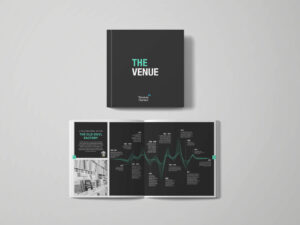There is something about physically holding a product that simply cannot be replicated digitally. It is proven to require 21% less cognitive effort to read and process content consumed from print rather than digital. People are 70% more likely to remember a brand they have seen in print than online and are more likely to recall the information for up to a week afterwards.
Print Marketing Reigns Supreme
Print is tangible, tactile and easier to process, resulting in generally higher average order values than equivalent companies across digital channels. Print marketing can incorporate different textures, cut-outs, materials and even smells, plus parts customers can cut out and take away, such as vouchers.
A study by Temple University researchers showed that we are much more likely to be emotionally motivated by a physical advertisement or printed media than online content. One great example of this is comparing direct mail to email marketing. It is said that the response rate is 37% higher for those receiving something in their letterbox rather than their inbox.
Localised marketing such as flyers, posters and billboards is more likely to be seen by the intended target audience than a social media post. As much as technology is advancing so that targeted ads online are so much more reliable, even if you hit that audience, they may scroll past it once. Compared to a poster they see every morning on their walk to work.

In an undeniably digital world, many people sit on their phones or computers all day at work and then spend the evening scrolling through social media or consuming adverts watching the television. This can lead to information overload, and people like to reach out to physical media to help them switch off. A brochure, magazine or other form of print marketing are often seen as a more relaxed form of reaching an audience. The reader chooses for themselves when they would like to pick it up and read it, and they tend to take more time and read it more deliberately than in the fast-paced online world where skim reading is much more likely.
A staggering 86% of people suffer from something known as banner blindness. We are so aware of ads online that we have managed to train our brains to simply look past them. There is much less competition within print publications allowing more space for your print marketing to stand out and grab the reader’s attention.
For retail bricks and mortar brands on dying high streets, staying ahead of the curve is of utmost importance, and they are always seeking new ways to engage new customers and make their branding more eye-catching. However, some of their most successful campaigns are still print-based. Think about window displays, floor graphics, building wraps etc and how they demand attention. Just seeing something in person that catches your eye makes you more likely to engage with it and remember it in the future.
Trusted Marketing
Perhaps the biggest reason print marketing holds so much importance in the digital age is trust. We have all grown up surrounded by books, magazines, and newspapers. This longevity and relationship with print are why we tend to place a greater deal of trust and credibility in printed materials and the content we read within them. UK Stats show that printed media is the second most trusted source of advertising and marketing, behind television, with digital sources falling behind. Paper speaks louder than pixels, and printed media is considered less invasive, with no annoying pop-ups. Cyber attackers do not create print material, and no one has ever received a virus from a printed leaflet.
The Best Marketing Strategy
So, are we saying to complete forget digital and refocus all your marketing efforts on print? Not at all! One medium does not kill another. When television came along, that didn’t kill the radio. They have different and equally important roles.
The best marketing strategies combine both. They are equally vital areas of marketing that should be used to complement each other and, if done well, will make your campaigns much more effective. Some ways digital and print can be used together include adverts, posters, or brochures with a clear call to action to shop online and interactive billboards; these can attract much more attention and generate more conversation than any poster or social media post.
Another key example of combining the two is by including QR codes on printed materials that readers can scan with their smartphone and be led straight to a website landing page. We recently created new business cards for our business. These metallic cards were designed in-house, featuring a sophisticated design, engraving and a QR code that provides people with instant access to our website and automatically adds us as a contact on any mobile that scans it.
Having one copy of a business card that can be scanned by anyone you come into contact with reduces the chances of them getting lost as you don’t need to carry loads of them around with you. We believe the high-quality and sleek print finish of this product combined with the technology used gives a great first impression, and we look forward to creating more like these for our clients in the future.
